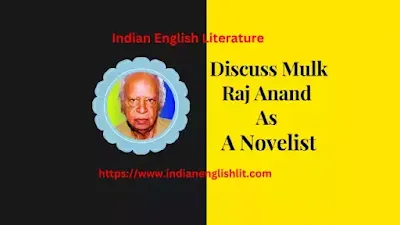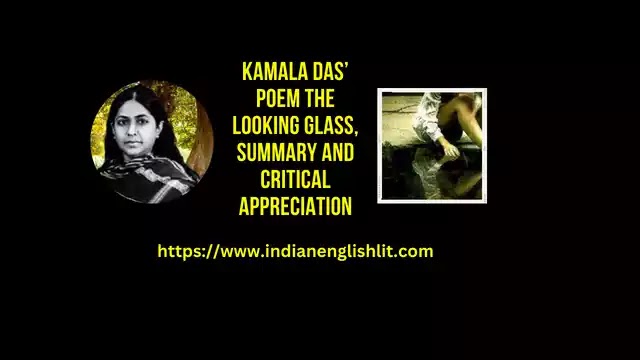Introduction:
Mulk Raj Anand is a very popular and famous Indo - Anglian novelist. He is a novelist of the under - dog and of the child life. He has stamina, stern consistency and talent. His creative span covers a period of over thirty - six years. He has written more than a dozen novels, about eighty short stories, a number of essays and articles.

Realism:
M. R. Anand was born in Peshawar and passed much of his life in Punjab, He, therefore, portrays Punjabi characters and Punjabi life with a great deal of realism. Convincing and credible accounts of the social manners, customs, ideas and beliefs are found in his novels. Many of his characters are modelled faithfully on people whom he actually new and met in his life. The character of Bakha and Munoo are modelled on the friends of his boyhood. Saros Cowasje, in ‘Introduction to Private Life of an Indian Prince’ remarks, “In his novels, for the first time, the Indian people had been clearly and intimately described with unflinching realism and deep understanding, and the exploiters, whether imperialists or feudalists exposed with uncompromising truth.” Mulk Raj Anand is the Munshi Prem Chand of Ando - Anglian fiction. Much of his fictional work can be compared with that of Charles Dickens, K. R. S. Iyengar says, “As a novelist Anand has been as effective almost as Dickens himself.” Dr. Iyengar remarks, “There is no doubt … a photographic fidelity about the picture that convinces at once, though it also overwhelms us by its cumulative ferocity and force of detail …. untouchable strikes us as the picture of decadent and perverted orthodoxy.”
Ugly and Seamy Side of Life:
Naturalism Anand is a minute observer of life, society and people. His realism is seen in the portrayal of all aspects of life, even the ugly and the seamy ones. Everything - dirt, squalor, beggars, poverty, disease and prostitution is beautifully described in his novels. Untouchable begins with a scene of public latrines, scenes of dirty bazars, lanes, alleys, of gutters in which the flow of dirty water is obstructed by soil filth. In other scene, Kali Nath tries to rape Sohini, the sweeper - girl. Ratha has a perpetually running nose and flies assemble on his face to taste of the Saliva on the corners of his lips. This is the ugly side of life and Anand has well described it in his novels. In this respect the novelist seems to be influenced by Zola and Balzac, the French writers.
The Purpose of His Novels:
There is an inherent social purpose in his novels. He does not believe in the theory of ‘Art’ for ‘Art's sake’ but writes for the sake of life, the theme of his work is the whole man or the whole gamut of human relationships. His novels and short stories are written with the purpose of teaching men to recognize the fundamental principles of human living and exercise vigilance in regard to the real enemies of freedom and socialism. He condemns the under - dog. Every one of his novels deals with some or other social problem. He is a proletarian novelist who ruthlessly condemns the man-made barrier between the caste - Hindus and the untouchables in his novel Untouchable. Coolie deals with labour problem of textile mills and pitiable conditions of domestic servants. The village discusses the problem of abject poverty and indebtedness, Two Leaves and a Bud deals with the exploitation of labourers in tea plantations. The Big Heart deals with the introduction of machines and consequent unemployment.
But the social problems dealt within his novels attain universal significance because of the artistic manipulation of his subject. He combines in his novels his European view of human conflicts and revolutions with his Indian sensibility of being sympathetic with the Indian people.
His Plot – Construction:
His plots are not governed by interplay of circumstances and character but by his zeal for revealing the social reality. He is more a social reformer than a postmaster. He is not a novelist of situations and events but of characters and of social reality. He picks up a character, builds up a background through incidents and gradually his character begins to live and breathe. Details are piled upon details, minute touches and suggestions are fully exploited to reveal the characters in full. His themes often have a beginning, middle and an end. The unities of time, place and action are followed in his novels. The action occupies one day and takes place in a small area in Untouchable. The private life of an Indian prince is well designed. The elements of suspense, pathos and humour are also intermingled in his plots.
Humour and Pathos:
He mingles humour and pathos in his novels and short stories. Both his men and women suffer immensely Bakha leads a very miserable life in Untouchable. He is a sweeper - boy and is ill - treated both by his old father and the high caste - Hindus. Kali Nath is frustrated attempt's to molest Bakha's sister touches the deeper springs of pity and sympathy in our hearts. The novelist enlivens the tension by introducing humorous touches. There is humour in Bakha's obsession for English dress and manners. The following sentences have childlike humour, “Again it was rumoured that a Sahib had once been court martialled for shooting a sepoy and since he was a white and could never be put behind the bars in the lock - up at the Quarter – guard, his hat and belt and sword had been imprisoned instead.”
Characterization:
Mulk Raj Anand is a delineator of characters. His Munoo, Bakha and Gangu are universalized figures. His central characters are as alive and immortal as those of Dickens, Hardy and Munshi Prem Chand. There are various types of characters in his novels. There are the Maharajas, the poor sweepers, the Anglo – Indians, the landlords, the soldiers, the policemen, the moneylenders, the clerks, the factory workers, the coolies, the washermen, the cobblers and the carpenters and so on. He is expert in sketching children but his women play subordinate role in comparison to men. He has few heroines.
Most of his characters are the reflections of the real people. There are two wide groups of characters, first, the victims of social injustice secondly the upholders of the unjust social order.
Autobiographical Element in his Novels:
The novels of Mulk Raj Anand have a powerful undercurrent of autobiographical element. The recurring description of life in Indian cantonments and villages, and the men and women who emerge in his novels are the reflections of the real situations and real people he had known during his childhood and youth. Bakha, a friend of the novelist during his childhood, is the central figure in Untouchable. Seven Summers is autobiographical from the start to finish. It narrates the novelist's experiences during the first seven years of his life. The picture of his orthodox mother, dominating father, friends Chota, Ali and Bakha are given in the novel. The Private Life of an Indian Prince is the story of the novelist himself. The characters in this novel have a close resemblance with the novelist, his English wife and the hill - woman. Anand fell in love with the hill - woman and divorced his English wife Kathleen. But the hill - women fell in love with a French man and ran away with him to Paris, Ganga Dasi has her origin in the hill - woman who prompted the author to divorce Kathleen Maharani Indira bears some relation to Kathleen. A critic remarks, “The Private Life of an Indian Prince refers to an emotional crisis in his own life.”
Art of Narration:
Mulk Raj Anand is a good story - teller. The interest of the reader is retained in the story from the first sentence to the last one of the book. He narrates convincingly, and when we take up his novels, we do not like to give up them unfinished. The narration is enlivened from time to time by the flashes of humour. There are a number of examples of humour spread throughout his novels. There are also touches of pathos that move the hearts of the readers, the novelist gives us absorbing narratives with an effective beginning and a clinching conclusion by using the devices of contrast balance, suspense and surprise. He presents Bakha's day as a graph of spirits soaring and invests the narrative with great dramatic interest. In The Old Woman and the Cow, the climax is reached on the last page of an eventful narrative. Village and Across the Black Waters are the stories told with consummate narrative skill. He adapts his narration to the requirement of his theme.
In his novels the narration moves forward chronologically, the action develops through interaction of character and character, and character and environment. But in The Big Heart and Untouchable he has followed ‘the stream of consciousness technique’. He used this stream of consciousness technique in a very different way from that of James Joyce and Virginia Woolf, so that it might not degenerate, into mere subjective withdrawal from ‘The outer social reality’. His aim is to present the under - dog of society not as he is in himself, but as a victim of social wrong and exploitation, and his technique is quite suited to his purpose.
Mulk Raj Anand confines the novel to human beings and to their relations with each other in the present excluding metaphysical or historical element. His novels are organic wholes; the form and the content are fully integrated. The form of his novels is a fusion of the western realistic tradition of the novel with the Indian tradition of the moral fable. The subject of his novels was not intellectual cross - currents in Europe but India as experienced by an Indian. He adapted the Indian tradition of moral fable to the novel which is a western art - form. He used two devices of the moral fable - first the desire image by which the novelist suggests what he would like life to be as against what it is, secondly the spokesman figure by using which the novelist promotes his social vision. In Untouchable the poet, is introduced as a spokesman figure to suggest that if the untouchables develop a sense of self - respect and India adopts the flush – system, the untouchability may be removed.
Language and Style:
The language of Mulk Raj Anand in his novels is a fine specimen of Indian English. It is correct and idiomatic. It is not like the British English. It has certain peculiarities which make its Indian origins unmistakably clear. Its oriental opulence, its passion to use more words than are necessary, and its fast galloping tempo typical of Indians who talk too fast, too loud and too much. For example there is a passage from Untouchable:
“As they sat or stood in the sun, showing their dark hands and feet, they had a curiously lackadaisical lazy, lousy look about them. It seemed their insides were concentrate in the act of emergence, of a new birth, as it were, from the raw, black, wintry feeling in their souls to the world of warmth. The taint of the dark, narrow, dingy little prison cells of their one - room homes lurked in them, however, even in the outdoor air.”
Mulk Raj Anand freely uses the English translation of Indian abusive expressions in his novels. Such abusive expressions as ‘son of a pig’ ‘one, the scoundrel of a sweeper's son’, abound in untouchable and many other novels. When he describes typical Indian scenes, situations and characters, he uses a language which is the literal translation of Indian utterances and experiences. The hue and cry that Gulabo raises at the sight of Sohini is an example of Anand's use of Indian English. “Ari, ari bitch! Do you take me for a buffon? What are you laughing at slut? Aren't you ashamed of showing your teeth to me in the presence of men, you prostitute?”
The novelist uses refined language tinged with emotions when he describes the beauty or dignity of the characters. Describing Sohini's beauty he writes, “She had a sylph like form, not thin, but full bodied within the limits of her graceful frame, well rounded on the hips, with an arched narrow waist from which descended the folds of her trousers and above which were her full round, globular breasts, jerking slightly, for lack of a bodice, under her transparent musslin shirt.” Sometime the novelist is pseudo poetic in his language. He writes, “Leila was shy like the dawn on some hill of mystery.” His images are taken from the perceptions of his peasants, for example, Lalu sailing down the placid Ganga finds the river like ‘a pregnant woman swollen with content’ and Munoo thinks that the taste of the fresh cotton thread in the factory is sickening ‘like bile in the mouth’.
Mulk Raj Anand uses Indian English in dialogues between Indian characters and good, spoken, middle class English in dialogues between British characters or when either of the two speakers is a British character. A critic remarks, “the speech of Anand's Indian characters is stamped through and through with an Indian colouring …”
He makes a good use of literal translation of Hindi or Punjabi proverbs into English. For example:
(1). That is the talk. (That is the thing.)
(2). There is no talk. (It does not matter.)
(3). There is something black in the pulse. (There is something fishy.)
(4). He was dead over her. (He was madly in love with her.)
(5). Why do you eat my head? (Why do you pester me?)
(6). After eating seven mice, the cat is going on a pilgrimage. (After committing sin many times, one pretends to be pious.)
Conclusion:
Mulk Raj Anand has contributed new technique, new matter, new approach and new style to Indo - Anglian fiction. He interprets Indian material, Indian life and the life of the under - dog in such a way that his novels come to have a universal appeal. He is compared with Prem Chand the Charles Dickens. He combines the East and the West both in his novels. He infuses note of high seriousness in Indo - Anglian fiction. His heroes are common men and sometimes sweepers and peasants also. He has the zeal of a reformer though he is not a propagandist but a pure artist writing for aesthetic values. His novels touch new themes - untouchability, poverty, hunger, exploitation and labour problem. His heroes are the common people who are exploited and oppressed by the so called high class people. It seems that the novelist is more concerned with the reformation of social ills and so he has sacrificed art on the altar of his reformatory zeal. His characters are repeated in his novels. His women characters are weak. The three villains - the priest, the moneylender and the landlord often occur in his novels. His plots are also loose his art and craftsmanship is impaired due to his high motive of reform.






